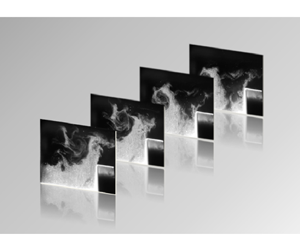Crossref Citations
This article has been cited by the following publications. This list is generated based on data provided by
Crossref.
Sujith, R. I.
and
Unni, Vishnu R.
2020.
Complex system approach to investigate and mitigate thermoacoustic instability in turbulent combustors.
Physics of Fluids,
Vol. 32,
Issue. 6,
Pavithran, Induja
Unni, Vishnu R.
and
Sujith, R. I.
2021.
Critical transitions and their early warning signals in thermoacoustic systems.
The European Physical Journal Special Topics,
Vol. 230,
Issue. 16-17,
p.
3411.
Ruiz, Eustaquio A.
Unni, Vishnu R.
Pavithran, Induja
Sujith, R. I.
and
Saha, Abhishek
2021.
Convolutional neural networks to predict the onset of oscillatory instabilities in turbulent systems.
Chaos: An Interdisciplinary Journal of Nonlinear Science,
Vol. 31,
Issue. 9,
Wang, Xinyao
Han, Xiao
Song, Heng
Yang, Dong
and
Sung, Chih-Jen
2021.
Multi-bifurcation behaviors of stability regimes in a centrally staged swirl burner.
Physics of Fluids,
Vol. 33,
Issue. 9,
Sujith, R.I.
and
Unni, Vishnu R.
2021.
Dynamical systems and complex systems theory to study unsteady combustion.
Proceedings of the Combustion Institute,
Vol. 38,
Issue. 3,
p.
3445.
Ramanan, Vikram
Baraiya, Nikhil A.
and
Chakravarthy, S. R.
2021.
Experimental analysis of two-period quasi-periodic oscillations in a turbulent hydrogen combustor.
Journal of Visualization,
Vol. 24,
Issue. 5,
p.
963.
Pawar, Samadhan A.
Raghunathan, Manikandan
Reeja, K.V.
Midhun, P.R.
and
Sujith, R.I.
2021.
Effect of preheating of the reactants on the transition to thermoacoustic instability in a bluff-body stabilized dump combustor.
Proceedings of the Combustion Institute,
Vol. 38,
Issue. 4,
p.
6193.
Krishnan, Abin
Sujith, R.I.
Marwan, Norbert
and
Kurths, Jürgen
2021.
Suppression of thermoacoustic instability by targeting the hubs of the turbulent networks in a bluff body stabilized combustor.
Journal of Fluid Mechanics,
Vol. 916,
Issue. ,
Sujith, R. I.
and
Pawar, Samadhan A.
2021.
Thermoacoustic Instability.
p.
285.
Roy, Amitesh
Premchand, C.P.
Raghunathan, Manikandan
Krishnan, Abin
Nair, Vineeth
and
Sujith, Raman I.
2021.
Critical region in the spatiotemporal dynamics of a turbulent thermoacoustic system and smart passive control.
Combustion and Flame,
Vol. 226,
Issue. ,
p.
274.
Raghunathan, M
George, N B
Unni, V R
Sujith, R I
Kurths, J
and
Surovyatkina, E
2022.
Seeds of phase transition to thermoacoustic instability.
New Journal of Physics,
Vol. 24,
Issue. 6,
p.
063008.
George, Nitin Babu
Raghunathan, Manikandan
Unni, Vishnu R
Sujith, R. I.
Kurths, Jürgen
and
Surovyatkina, Elena
2022.
Preventing a global transition to thermoacoustic instability by targeting local dynamics.
Scientific Reports,
Vol. 12,
Issue. 1,
Weng, Yue
Unni, Vishnu R.
Sujith, R. I.
and
Saha, Abhishek
2023.
Synchronization-based model for turbulent thermoacoustic systems.
Nonlinear Dynamics,
Vol. 111,
Issue. 13,
p.
12113.
Tandon, Shruti
and
Sujith, R.I.
2023.
Multilayer network analysis to study complex inter-subsystem interactions in a turbulent thermoacoustic system.
Journal of Fluid Mechanics,
Vol. 966,
Issue. ,
Raghunathan, Manikandan
George, Nitin Babu
Unni, Vishnu R.
Kurths, Jürgen
Surovyatkina, Elena
and
Sujith, R. I.
2023.
Inhibiting the onset of thermoacoustic instability through targeted control of critical regions.
International Journal of Spray and Combustion Dynamics,
Vol. 15,
Issue. 1,
p.
3.
Banerjee, Ankan
Pavithran, Induja
and
Sujith, R. I.
2023.
Imprints of log-periodicity in thermoacoustic systems close to lean blowout.
Physical Review E,
Vol. 107,
Issue. 2,
Zhang, Wenhui
Bi, Dianfang
and
Wei, Yingjie
2023.
Effect of porosity on the kinematics of free-falling porous disks.
Physics of Fluids,
Vol. 35,
Issue. 1,
Banerjee, Ankan
Pavithran, Induja
and
Sujith, R. I.
2024.
Early warnings of tipping in a non-autonomous turbulent reactive flow system: Efficacy, reliability, and warning times.
Chaos: An Interdisciplinary Journal of Nonlinear Science,
Vol. 34,
Issue. 1,
Xu, Boqi
Wang, Zhiyu
Zhou, Hongwu
Cao, Wei
Zhong, Zhan
Huang, Weidong
and
Nie, Wansheng
2024.
Detection of Precursors of Thermoacoustic Instability in a Swirled Combustor Using Chaotic Analysis and Deep Learning Models.
Aerospace,
Vol. 11,
Issue. 6,
p.
455.
De, Somnath
Bhattacharya, Soham
Bhattacharya, Arijit
Mondal, Sirshendu
Mukhopadhyay, Achintya
and
Sen, Swarnendu
2025.
Insights of transitions to thermoacoustic instability in inverse diffusion flame using multifractal detrended fluctuation analysis.
Physics of Fluids,
Vol. 37,
Issue. 8,


